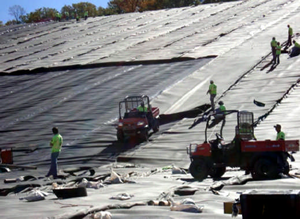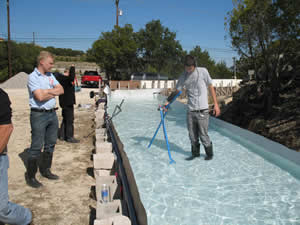 22 March 2010 – The demand for performing geoelectric integrity surveys as the final stage of liner construction quality assurance (CQA) has significantly increased. This has been spurred not only by regulator understanding and wide-spread use in the waste management sector but also by other closely monitored, environmentally concerned industries such as mining, wastewater and fuel/oil storage.
22 March 2010 – The demand for performing geoelectric integrity surveys as the final stage of liner construction quality assurance (CQA) has significantly increased. This has been spurred not only by regulator understanding and wide-spread use in the waste management sector but also by other closely monitored, environmentally concerned industries such as mining, wastewater and fuel/oil storage.
It’s prompted a number of companies and agency representatives to pursue training for conducting liner integrity surveys, either as an additional service their business might offer or to aid in the authoring of regulations. The once small pool of liner integrity survey experts is increasing, and that’s leading both to greater competition in performing the work but also greater awareness of the benefit of these surveys.
In Florida, for example, the Department of Environmental Protection has updated its landfill construction codes to include geoelectric liner integrity surveys as a final CQA option on primary and secondary containment liners. In exchange for performing these surveys on site, site operators then need only to have destructive seam samples taken every 1000 ft. (rather than every 500 ft without the liner integrity survey). This speeds up installation while improving safety, and it reduces both destructive testing costs and the number of patches that must be made (from those zones at which destructive seam samples are taken).
AN IN-DEMAND SKILL
There’s only one place in the United States right now to learn how to perform geoelectric integrity surveys: from the TRI-CORP Liner Integrity Center (T-CLIC), which is a joint venture of the independent testing laboratory TRI/Environmental and the engineering firm I-CORP INTERNATIONAL, Inc. They offer both classroom and field training and follow-up audits; and they are aided by guest instructors and input from other established CQA and design firms.
The next "CQA Week" with training opportunities will be held April 12-16 in Austin, Texas. The full week will include two days of liner integrity training, two days of CQC/CQA courses (geosynthetic installation, compacted clay and geosynthetic clay liner installation), and a CQA certification exam. See a PDF brochure of the week’s offerings here.
Early registration ends April 2, so register today.
Why attend the April 12/13 geoelectric liner integrity survey course at TRI? There are many sound reasons:
- Learn how this increasingly required technology works
- Understand the boundary conditions required to perform an effective survey
- Identify lining systems that can and cannot be surveyed
- Learn why a single liner covered by soil may not be surveyable
- Learn why a double liner with a geocomposite LDS may not be surveyable
- Know when to do a survey if you are an installer, an owner, or a regulator
- Understand the equipment and its limitations
- Learn why calibration is so critical
- Check out complementary and newly developing survey techniques
- Try hands-on surveys and get a feel for them
- Check the statistics of numbers, locations, and causes of leaks
- Start the process of certification
- Tour the TRI geosynthetics laboratory
- See how surveys can assure the quality of an installer’s work
- See how surveys maximize a CQA firm’s efforts
- See how surveys can be a revenue generator for CQA firms
- Be assured that surveys do decrease the leakage rate through geomembranes
- Stay current with technology
- See why we’re worried if we do not find any leaks
- Learn how to design a lining system and appurtenances if surveys will be required
- Be one of the first in your region to assure your work or to provide the service to others
- Leave the cold north behind for two or three days
 To date, T-CLIC’s liner integrity survey and assessment (LISA) training program has welcomed roughly 200 participants to the 1-day classroom and 1-day, hands-on field course which takes place in test cells that simulate different field conditions such as exposed geomembranes, water covered and soil covered. The exposed liner even has three different substrates: conductive geomembrane, conductive geotextile, and geosynthetic clay liner (GCL).
To date, T-CLIC’s liner integrity survey and assessment (LISA) training program has welcomed roughly 200 participants to the 1-day classroom and 1-day, hands-on field course which takes place in test cells that simulate different field conditions such as exposed geomembranes, water covered and soil covered. The exposed liner even has three different substrates: conductive geomembrane, conductive geotextile, and geosynthetic clay liner (GCL).
While most sessions have been held at the TRI/Environmental campus in Austin, Texas, special sessions have been held by request of government agencies and private companies in Houston, Texas; Albany, New York; Halifax, Nova Scotia; Edmonton, Alberta; and Manila, the Philippines.
Of those who have taken the liner integrity survey course, 39 (as of February 2010) have proceeded to a one- or two-day field audit during their first or a subsequent production survey followed by a 90-minute closed book written test of 40 questions based on actual surveys. Of these 39, 24 have achieved T-CLIC certification.
More information is available at www.tri-env.com/reg/.











